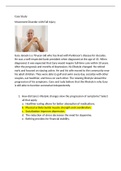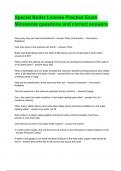Case Study Movement Disorder with Fall Injury Gary Jansek is a 70-year-old who has lived with Parkinson’s disease for decades. He was a well-respected bank president when diagnosed at the age of 45. When diagnosed, it was expected that Gary would require full-time care within 10 years. After the prognosis and months of depression, his lifestyle changed. He retired early and focused on staying active. He and his wife moved to the community near
his adult children. They were able to golf and swim every day, socialize with other couples, eat healthier, and focus on each other. The relaxing lifestyle slowed the progression of his symptoms. Gary and Judy believe that this lifestyle is why Gary is still able to function somewhat independently. 1.How did Gary’s lifestyle changes slow the progression of symptoms? Select all that apply.
a.Healthier eating allows for better absorption of medications. b.Physical activity builds muscle strength and coordination. c.Socialization improves depression. d.The reduction of stress decreases the need for dopamine. e.Retiring provides for financial stability. Gary is beginning to fall several times a week. He sometimes feels that his feet “stick to the floor” and when he cannot get moving he falls forward. At other times he becomes very dizzy when standing and loses his balance. He and Judy make an appointment with the provider to discuss their concerns. 2.The nurse completes and assessment, which finding is most concerning?
a.Large hematoma on the right hip.
b.Tremors of the fingers and hands, right worse than left.
c.Hunched stature.
d.Shuffling gait.
3.The nurse is unfamiliar with Gary’ medication and accesses resources to learn more. Highlight the areas of the information that is most concerning to his current situation. Levodopa/Carbidopa Selegiline Benztropine Classification: Dopamine agonist,
Antiparkinsonian agent. Dose and Administration: 25 mg carbidopa/100 mg levodopa 3 times a day; may increase till effect is achieved (max – 8 tables/day)
Side Effects: involuntary movements, dizziness, blurred vision, mydriasis, nausea dry mouth, melanoma, anemia, leukopenia. Precautions: Contraindicated in glaucoma, MAOI therapy. Use cautiously with a history of cardiac, psychiatric or ulcer disease. Assessment: Parkinsonian and extrapyramidal symptoms, lab abnormalities, blood pressure monitoring during dose change. Classification: Monoamine Oxidase Type B Inhibitor (MAOI), Antiparkinsonian agent. Dose and Administration: 5 mg twice a day with food. Side Effects: Confusion, dizziness, fainting , melanoma, nausea, dry mouth.
Precautions: Do not give with meperidine, opioid analgesics, SSRIs or tricyclic antidepressants. The side effect can be life-threatening. Assessment: Parkinsonian symptoms, blood pressure.Classification: Anticholinergic, Antiparkinsonian agent. Dose and Administration: 1-2 mg/day in 1-2 divided doses Side Effects: Confusion, depression, dizziness, arrhythmias, hypotension, constipation, dry mouth, urinary retention. Precautions: Contradicted in angle-closure glaucoma and with tardive dyskinesias. Use cautiously with cardia dysrhythmias . Assessment: Parkinsonian and extrapyramidal symptoms, bowel function, monitor constipation, measure intake and output, orthostatic hypotension .





